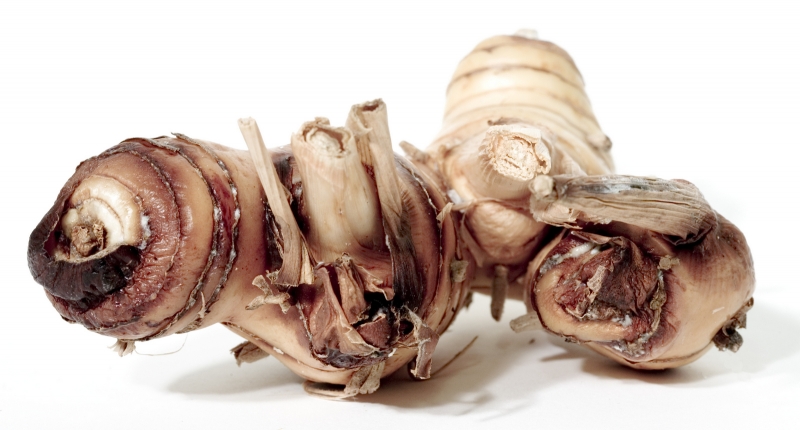
Galangal is often used in Indonesian and Southeast Asian dishes, and Australians often discover its distinctive taste after travelling to Bali or Thailand. At a glance, galangal resembles regular ginger as it is, after all, a member of the same rhizome family, but that is where the resemblance ends. Read on to discover the true nature of galangal and if it has any health benefits you should know about.
What is Galangal?
Galangal, sometimes called blue ginger, lesser galangal, Siamese or Chinese ginger, is a member of the Zingiberaceae (ginger) family. Specifically, galangal refers to the rhizome (underground stem) that is used for cooking and medicinal purposes. In Vietnam, it is used in popular Hue dishes; in Thailand and Laos, it is used in making tom yum; in Indonesia, where the plant originates, it is used extensively in beef soups and a number of dishes.
Galangal has been used as medicine for centuries and its health benefits have been recognised throughout Asia and Indonesia for centuries. A popular tonic in Southeast Asia when mixed with lime juice, galangal is also used as a digestive aid in Traditional Chinese Medicine (TCM) and is said to help ease the symptoms of arthritis by many naturopaths and traditional healers. These reported health benefits are reflected in its use in homoeopathy for relief from nausea, diarrhoea, flatulence and rheumatism.
How Do You Use Galangal?
While galangal looks very much like ginger, it has a distinctively different flavour that is hard to identify until you have tasted it. Some liken it to pepper, while others emphasise its earthy, "perfumy" flavour and citrus scent. Fresh galangal is used like ginger: it can be grated, thinly sliced or crushed. Fresh galangal should snap rather than bend. If you can't find the spice in its raw form in your local grocery store, you may be able to find it in dried or powdered form. If you use dried galangal, soak it in hot water first to release its flavour.
Once very hard to find in Australian supermarkets, galangal's increasing popularity has made it much easier to find in most major Australian cities. Look for it in the Asian produce section of your supermarket, in oriental grocery stores and in health food stores.
What are the Benefits of Galangal?
Galangal is a pantry staple for many reasons. It's not only an essential ingredient for enhancing the flavour of every kitchen recipe but also used to treat common ailments and life-threatening health conditions as well. Scientific research shows that it can help strengthen the immune system, treat infertility in men by increasing sperm count and prevent certain forms of cancer, including liver cancer, breast cancer, leukemia, pancreatic cancer and skin cancer.


A 2017 study found that active compounds extracted from galangal can stop the growth of new cancer cells and curb the spread of the disease in the body. The spice is also packed with antimicrobial and anti-inflammatory agents that prevent the development of a wide range of physical and mental health issues. The positive effects of galangal are well-documented, especially for the treatment of the following:
- Rheumatoid arthritis
- Heart disease
- Knee and joint pain
- Motion sickness
- Fungal infections
- High cholesterol levels
- Hypertension
- Diabetes
- Digestive issues
- Chronic inflammation
- Depression
- Alzheimer's disease
- Skin conditions
- Respiratory ailments
How Do You Cook Galangal?
The beauty of galangal is that it's a therapeutic herb disguised as a regular rhizomatous spice for a curry recipe or vegetable stir-fry. It's a powerful antioxidant that doesn't require a lot of work. Just throw it into any dish, savour its tangy flavour, which is a cross between lime and ginger, and leave it to magically banish any symptom of inflammation, pain or discomfort.
If you've never used a galangal root before, you'll be happy to know that it only takes a few seconds to prepare it. You just need to peel off the skin, then chop, mince or grate it before adding it to the dish that you're preparing. It can be used in practically any recipe — soups, pasta sauces, desserts and what have you.
Galangal is commonly used in Asian recipes, particularly Thai and Indonesian, to add a punch of flavour or to conceal the fishy smell in seafood dishes. To speed up your cooking, you may opt for galangal powder which is really great for vegetable soup.
In Ayurvedic medicine and TCM, it's often chopped or minced and prepared as herbal tea to restore balance and harmony in the human body. The extract of galangal is a rich source of iron, vitamins A and C and phytonutrients that help nourish the cells, improve blood circulation and boost immunity.

Where Can You Source Galangal?
Keeping a supply of galangal is no different to stocking your medicine cabinet, except that you don't have to wait until you're sick to prepare a bowl of soothing galangal soup with coconut milk because unlike synthesised drugs, the galangal rhizome doesn't come with any side effects.
If you're almost out of galangal, you can purchase some at the Asian market in your neighbourhood. You will notice a significant price difference between a supermarket and an Asian store, plus the latter is a better option if you're looking for fresh galangal.
Alternatively, you may buy some online. In fact, online natural food stores offer galangal paste, black galangal and galangal extracts in addition to fresh galangal root to meet all of your cooking needs and improve your wellbeing.
|
Do you have a natural health & wellness business? |








